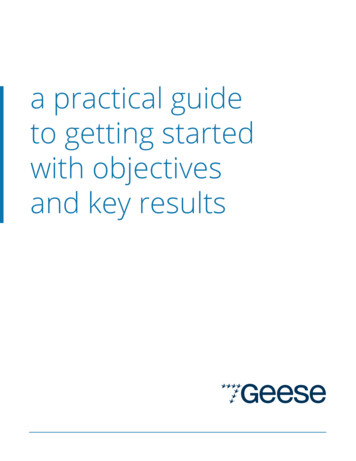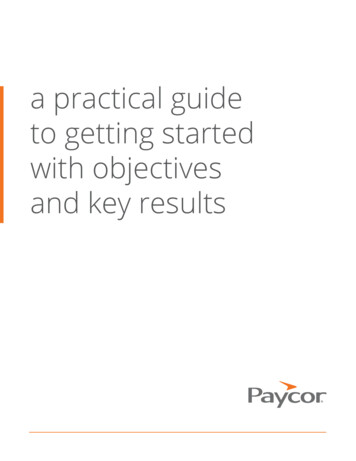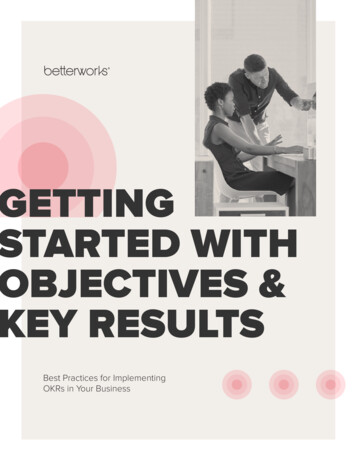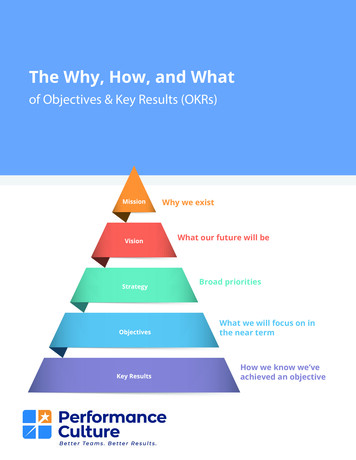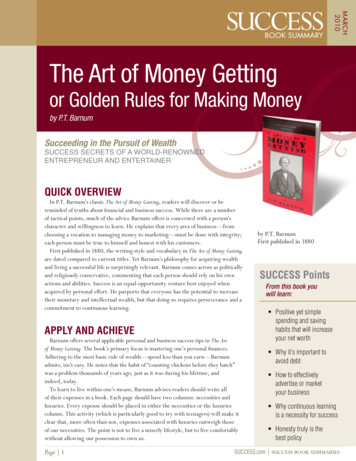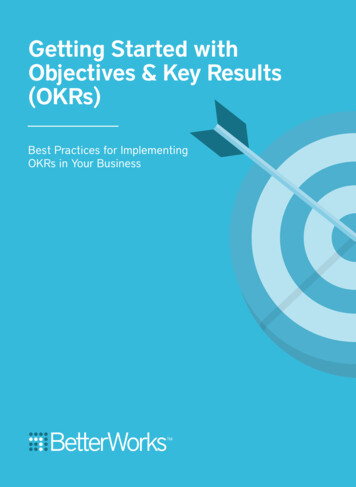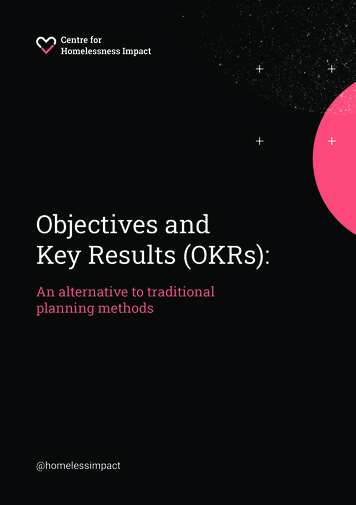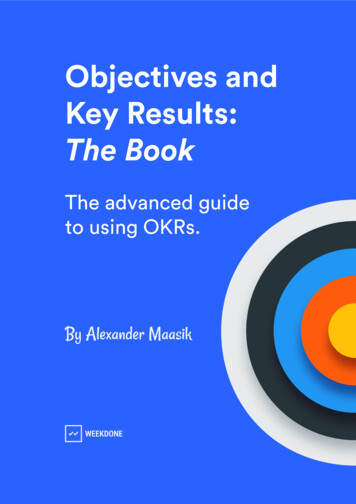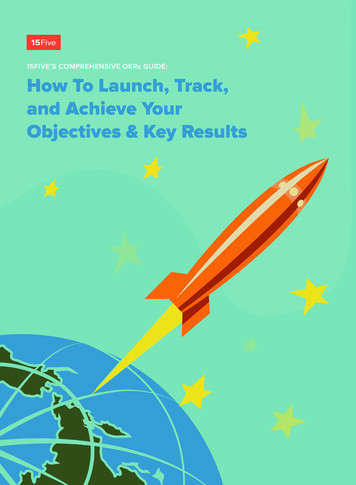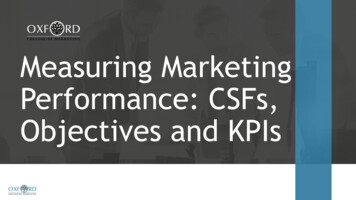
Transcription
Achieving Success with OKRsMariya Breyter, Enterprise Transformation Leader
Psychological nWhy am I here?My specialty is transformingorganizations, large and small, to aLean and Agile mindset.www.agileleantransformation.com
WHY DO WE NEED OKRs?Everything is #1 priority – we’re pulled in all directions.How will we know when we’re done?Why are we doing this?Our dependencies are misaligned.I did not know this was expected.
WHY IS THIS IMPORTANT?Ivan Krylov, “Swan, Pike, and Crawfish” (1814)Once Crawfish, Swan and PikeSet out to pull a loaded cart,And all together settled in the traces;They pulled with all their might, but still thecart refused to budge!The load it seemed was not too much forthem:Yet Crawfish scrambled backwards,Swan strained up skywards, Pike pulledtoward the sea.Who's guilty here and who is right is not forus to say —But anyway the cart's still there today.
WHAT ARE OKRs?“I will (Objective” as measured by (Key Results)”12OKRs bring alignment and focus aroundmeasurable goals.Objectives are memorable qualitativedescriptions and what we want toachieve.34Key Results are a set of metrics thatmeasure out progress towards theObjective.OKRs set a simple cadence that engageseach team’s perspective and creativity.The goal is to ensure that everyone is going in the same direction, with clear priorities, in a constant rhythm.
TAKING ENTERPRISE AGILITY to a new level with OKRsOKRs cascade across the enterprise, thus aligning all functions and creating transparent outcomes.ORGANIZATIONAL GOAL PERSPECTIVEINDIVIDUAL GOAL PERSPECTIVEOKRs help companies set goals atenterprise level and then focus onachieving the outcomes.Well-defined goals in an agileenvironment foster individuals’motivation and their ability to learnand grow.Agile programs manage dependenciesby removing waste and reducingvariation.PROGRAM GOAL PERSPECTIVETeam-level objectives enables teams’collaboration and their ability toinnovate and cross-pollinate.TEAM GOAL PERSPECTIVE
Machine LearningApproachto OKR setting
OKR Anti-Patterns
GOOD or BAD OKRs?OBJECTIVE - Improve efficiency with a data-driven approach to salesKEY RESULT 1 – Complete Salesforce cutover to reduce cycle time by 15%KEY RESULT 2 – Record all validated opportunities in Salesforce Enterprise InstanceKEY RESULT 3 – Achieve 4x pipeline coverage ratioKEY RESULT 4 – Increase average deal size from 20.5K to 32KKEY RESULT 5 – Qualify all sales-ready leads within 7 days
GOOD or BAD OKRs?OBJECTIVE - Become #1 free mobile banking app in Europe byKEY RESULT 1 – Deploying three new features by OctoberKEY RESULT 2 – Launching a marketing campaign in three languages by AugustKEY RESULT 3 – Redesigning visuals and layout of the website
ANTI-PATTERN 1: “LAUNDRY LIST”OBJECTIVE - Become #1 free mobile banking appin Europe byKEY RESULT 1 – Deploying three new features byOctoberKEY RESULT 2 – Launching a marketing campaignin three languages by AugustKEY RESULT 3 – Redesigning visuals and layout ofthe website
ANTI-PATTERN 2: “DON’T LOOK BACK”QuarterlyOKRsDailyalignmentSet and MonthlyReviewsEstablish a repeatablecadence: set quarterly,review monthly,execute weekly, aligndaily
GOOD or BAD OKRs?OBJECTIVE - Support all internal systems byKEY RESULT 1 – Following all operational proceduresKEY RESULT 2 – Providing tracking and monitoringKEY RESULT 3 – Following all service level parametersKEY RESULT 3 – Ensuring proper uptimeKEY RESULT 4 - Providing secure connectionsKEY RESULT 5 – Ensuring data securityKEY RESULT 6 – Enabling user logonKEY RESULT 7 – Cataloguing all systems on a regular basisKEY RESULT 8 – Providing proper documentation
ANTI-PATTERN 3: “BAU SYNDROME”OBJECTIVE - Support all internal systems byKEY RESULT 1 – Following all operational proceduresKEY RESULT 2 – Providing tracking and monitoringKEY RESULT 3 – Following all service level parametersKEY RESULT 3 – Ensuring proper uptimeKEY RESULT 4 - Providing secure connectionsKEY RESULT 5 – Ensuring data securityKEY RESULT 6 – Enabling user logonKEY RESULT 7 – Cataloguing all systems on a regular basisKEY RESULT 8 – Providing proper documentation
GOOD or BAD OKRs?OBJECTIVE - Increase efficiency of QA processesKEY RESULT 1 – Test cases for all P1, P2 stories are completed & handed over to dev before developmentstarts (compliance to be measured every sprint)KEY RESULT 2 – 1 week before release date, no blockers & critical bugs should be openKEY RESULT 3 – Bug leakage to production for critical issues is less than 1%KEY RESULT 4 – Less than 3 bugs reported by end users per release
ANTI-PATTERN 4: “MISMATCHED O/KRs”OBJECTIVE - Increase efficiency of QA processesKEY RESULT 1 – Test cases for all P1, P2 stories arecompleted & handed over to dev beforedevelopment starts (compliance to be measuredevery sprint)KEY RESULT 2 – 1 week before release date, noblocker & critical bugs should be openKEY RESULT 3 – Bug leakage to production forcritical issues is less than 1%KEY RESULT 4 – Less than 3 bugs reported by endusers per release
GOOD or BAD OKRs?OBJECTIVE - Increase the number of stores by 10%KEY RESULT 1 – Open new storesKEY RESULT 2- Implement new store designKEY RESULT 3 – Attract new shoppers in three new geographiesKEY RESULT 4 – Receive positive feedback from customersKEY RESULT 5- Ensure no impact on online store profits
BANTI-PATTERS 5: VAGUE/HARD-TO-MEASURE OKRsOBJECTIVE - Increase the number of storesby 10%KEY RESULT 1 – Open new storesKEY RESULT 2- Implement new store designKEY RESULT 3 – Attract new shoppers inthree new geographiesKEY RESULT 4 – Receive positive feedbackfrom customersKEY RESULT 5- Ensure no impact on onlinestore profits
OTHER ANTI-PATTERNS TO WATCH FORUnrealistic OKRsIrrelevant OKRsTop-down OKRsSet-in-stone OKRsPerformance OKRs
Exercise 1:Re-write an OKRin 5 minutes
GOOD or BAD OKRs?1OBJECTIVE - We will achieve a higher operationalavailability and lower operational costs asmeasured byKEY RESULT 1 – Zero DevOps owned services in Provider (move everything to the cloud)KEY RESULT 2- 10% reduction in cloudimplementation operational costKEY RESULT 3 – Zero single points of failure2OBJECTIVE - We will deliver working software tothe customer every sprint with high quality byKEY RESULT 1 – Delivering to production everysprint (no single release is more than 1 day late)KEY RESULT 2- Achieving over 80% regressiontest automationKEY RESULT 3 - Increasing unit test coverage to75 % from current 45 %KEY RESULT 4 - Implementing a continuousmonitoring tool to ensure “six nines” uptime forlower environmentsKEY RESULT 5- Enabling engineers manage lowerenvironments within required SLAs
IMPROVING OKRsUse this as anexampleOBJECTIVE - We will achieve a higher operationalavailability and lower operational costs asmeasured byKEY RESULT 1 – Zero DevOps owned services in Provider (move everything to the cloud)KEY RESULT 2- 10% reduction in cloudimplementation operational costKEY RESULT 3 – Zero single points of failureWhat is wronghere?OBJECTIVE - We will deliver working software tothe customer every sprint with high quality byKEY RESULT 1 – Delivering to production everysprint (no single release is more than 1 day late)KEY RESULT 2- Achieving over 80% regressiontest automationKEY RESULT 3 - Increasing unit test coverage to75 % from current 45 %KEY RESULT 4 - Implementing a continuousmonitoring tool to ensure “six nines” uptime forlower environmentsKEY RESULT 5- Enabling engineers manage lowerenvironments within required SLAs
Exercise 2:Write your own OKRin 5 minutes
ZOOM VIDEO COMMUNICATIONSZoom Video Communications Mission StatementOur mission is to develop a people-centric cloud service that transforms the realtime collaboration experience and improves the quality and effectiveness ofcommunications forever.Zoom Video Communications Vision StatementVideo communications empowering people to accomplish moreExercise: In 5 minutes, create one hypothetical Zoom OKRs for2021. Document your assumptions. Post in the chat.
OKR WORKSHOP STEP 1: DefineCompany OKRAnnual Objective:KR1:KR2:KR3:1State your mission.3Split it into key results.2Formulate a compelling objective.4Share and get feedback.
Step 2. ALIGN
“Don’t limit yourchallenges.Challenge yourlimits.”- Jerry Dunn
Sample Objective: Improve ApplicationQuality, Stability and ReliabilityKey Result 1: Reduce number ofproduction defects by 50%Key Result 2: Improve qualityof delivery within a sprintQM: Reduce the number ofmissed defects to no morethan 1 per 3 releasesRelease Mgmt: Guide theprocess via reviews,reporting, and strategydefinitionDev: Ensure 100%compliance with codequality standardsDev: Establish 100%coverage for peerreviewsDev: Ensure 100%knowledge transfer andSME on core systemsChief of Staff: EstablishProduction SupportTeam & define theprocessRelease Mgmt: Ensurethat no stories withbugs open against themare deployed intoproduction (exception:risk accepted stories)QM: 100%regressionautomation; 80%test automationAgile Practice: Ensure that20% of sprint capacity isallocated to defect fixingArchitecture: 100%architecture reviewscompleted within a sprintDevOps: Environmentsetup allows forintegration testingDevOps: Logging andMonitoring establishedwith clear highlyautomated processesQM&Dev: PilotTDD practices for2 teamsQM: 100%regressionautomation; 80%test automationKey Result 3: Increase SystemStability and Reliability by 30%Data: 99% datastabilityData: 99.9% dataaccuracyArchitecture: Proactivearchitecture definitionand communication biweeklySecurity: Securesolutions defined,established andmonthlycommunicatedAgile Practice: ensure that eachbacklog is balanced betweenfunctional user stories and nonfunctional technical tasks
Objective: Improve Customer ExperienceKey Result 1: NPS score goes 2points upKey Result 2: Implement 10 highestpriority features on a quarterlybasisCustomer Service:Product:Customer Service:Product:IT: DeliveryIT: Production SupportIT: DeliveryIT: ProductionSupportAgile Practice:Solution Architecture:Agile Practice:SolutionArchitecture:Sales:Marketing:Key Result 3: Establish acontinuous customer feedbackloop via three channelsCustomer Service:Analytics:Other functions?Product:Security:
OKR WORKSHOP STEP 2: Align1Select an alignment area.2Define your org structure and related OKRs.3Create a cascading view of your OKRs withclear ownership.
Step 3. REFINE
“Measure what ismeasurable andmake measurablewhat is not.”- Galileo Galilei
Company OKR: Respond to market needs by delivering new functionality to globalcustomers dailyObjective: We will enable daily production deployments to global customers with high quality at no additional expense byKR1: Performing 80% of application testing without requiring an integrated environment.KR2: Enabling daily deployments with full regression testing.KR3: Reducing high priority and critical production defects to no more than one per 20 deployments.ObjectiveKey ResultsScoreQ1: Improve application architecture todecouple solutions for testing anddeployment purposesPerform 80% of application testing without requiring anintegrated environment0-integrated environment is required in 100% of testing; 0.5 –50%; 1- integrated environment is required in 20% of testingDeploy the application independently from otherservices/applications it depends on0 – deployments are tightly coupled; 0.5 – deployments areloosely coupled; 1 – components can be deployedindependently on demandQ2: Ensure that all delivery teams arecross-functionalAll delivery teams have skills necessary to design, develop,test, deploy, and operate the system on the same team0 – none of the teams are cross-functional; 0.5 – 50% of teams,1- 100% of teams are cross-functionalEach team has access to manage relevant lowerenvironments with a dedicated team member authorized toperform production deployments0 – no access, all done by a dedicated team; 0.5 – lowerenvironments only, 1 – all environments including productionwithin agreed upon processOptimize deployment tools and frameworks to enable dailydeployments with full regression testing0 – no changes; 0.5 – implement daily deployments with somemanual testing; 1- full regression automationEnsure necessary skills are in place on each team0 – no training; 1- train everyoneEnsure all technologies are correctly licensed0 – no audit; 1- internal audit, 100% confirmedReduce high priority and critical production defects to nomore than one per 20 deployments0 – more than 5 defects per 20 deployments (current data), 0.5– no more than 3 defects, 1 – no more than 1 defectQ3: Ensure proper deployment tools andrelated skillsQ4: Build quality in by implementing BDDfor 100% of regression testing
OKR WORKSHOP STEP 3: Refine12For each of your objectives, createquarterly KRs.Come up with pre-grading for each KR.34For each external dependency, get ahandshake. If not possible, refine until it isachievable.Agree on ownership.Annual Objective:KR1:KR2:KR3:Q1 ObjectiveQ1 Key ResultsPre-grading/Score
Step 4. ITERATE
“Continuousimprovement isbetter than delayedperfection.” - Mark Twain
Sample Annual OKR Cadence AnnounceEnterprise OKRs Divisional OKRDrafting AlignmentWorkshopsEarlyNov.Mid-Nov.End ofDec. –early Jan.EarlyDec. Review the gradingof last year’s OKRs OKR Kick OffQ1 grading andrefinement Team OKR draftingand alignment OKR RetrospectiveQ2 grading andrefinementQ3 grading andrefinementQ4 grading andrefinement
SUMMARY: 4-STEP OKR PROCESS1. Set up AnnounceEnterprise OKRs2. Align Review andgrading of lastyear’s OKRs OKR Kick OffNov.End ofDec. –early Jan.Mid-EarlyNov.Dec.Early Divisional OKRDrafting AlignmentWorkshops4. Iterate Team OKRdrafting andalignment OKR RetroQ1ObjectiveQ1 KeyResults3. RefineScore
OKR BIGGEST SECRET“The greater danger for most of us lies not insetting our aim too high and falling short; but insetting our aim too low, and achieving our mark.”- MichelangeloLet’s Play OKR y-by-mariya39
OKR ManifestoYou can find me gileleantransformation.commaria breiter@yahoo.com
“I will (Objective” as measured by (Key Results)” 1 2 OKRs bring alignment and focus around measurable goals. Objectives are memorable qualitative descriptions and what we want to achieve. 3 Key Results are a set of metrics that measure out progress toward
